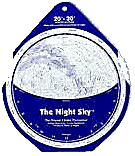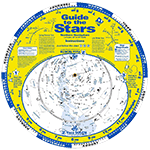|
2
|
Moon near Uranus (evening sky) at 0h UT. Mag. +5.8.
|
|
5
|
Moon near the Pleiades (evening sky) at 10h UT.
• The Pleiades (Wikipedia)
|
|
6
|
Moon near Aldebaran (midnight sky) at 3h UT.
• Aldebaran (Wikipedia)
|
|
6
|
Full Moon at 12:26 UT.
|
|
8
|
Mercury at superior conjunction with the Sun at 10h UT. The elusive planet passes into the evening sky.
• Superior & Inferior Conjunctions (Wikipedia)
|
|
9
|
Moon near Pollux (morning sky) at 15h UT.
|
|
10
|
Moon near Beehive Cluster (morning sky) at 19h UT.
• Beehive Cluster (Wikipedia)
• M44: The Beehive Cluster (APOD)
|
|
12
|
Moon near Jupiter (117° from Sun, morning sky) at 1h UT. Mag. -2.3.
|
|
12
|
Moon near Regulus (morning sky) at 16h UT.
|
|
12
|
Moon at apogee (farthest from Earth) at 23h UT (distance 404,581 km; angular size 29.5').
|
|
14
|
Geminid Meteor Shower peaks at 12h UT. Major activity lasts almost 24 hours around peak time. Produces bright, medium-speed meteors at its peak (up to 80 meteors/hour). Most reliable meteor shower. Easy to observe (radiant shown on sky map). Best seen after midnight.
• Observing the Geminids (Gary Kronk)
• Meteor Shower Calendar (IMO)
|
|
14
|
Last Quarter Moon at 12:53 UT.
|
|
17
|
Moon near Spica (61° from Sun, morning sky) at 3h UT.
|
|
19
|
Moon near Saturn (28° from Sun, morning sky) at 21h UT. Mag. +0.5.
|
|
21
|
December solstice at 23:03 UT. The time when the Sun reaches the point farthest south of the celestial equator marking the start of winter in the Northern Hemisphere and summer in the Southern Hemisphere.
• December Solstice (Wikipedia)
|
|
22
|
New Moon at 1:35 UT. Start of lunation 1138.
• Lunation Number (Wikipedia)
|
|
23
|
Moon near Venus (14° from Sun) at 3h UT.
|
|
24
|
Moon at perigee (closest to Earth) at 17h UT (364,797 km; angular size 32.8').
|
|
25
|
Moon near Mars (evening sky) at 5h UT. Mag. +1.1.
|
|
28
|
First Quarter Moon at 18:32 UT.
|
|
29
|
Moon near Uranus (evening sky) at 5h UT. Mag. +5.8. Occultation visible from Alaska, USA.
|
|
All times Universal Time (UT). USA Eastern Standard Time = UT - 5 hours.
|


